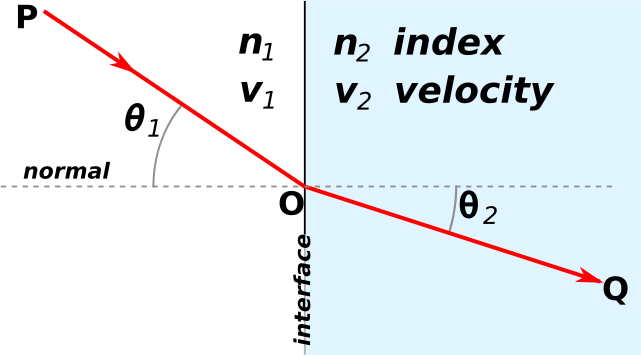Celeritas. The Latin word for speed shortened to c is used to represent the speed of light. c is a part of the most famous equation in science E = mc2. The speed of light being a universal constant 3 x 108 m/s is well known, and forms the crucial base on which Einstein's theory of relativity rests.
What is often left out are the words "...in space". Light has the speed of 3 x 108 m/s in space, and like this post mentions, it has different speeds in different mediums.
Eyes found in earthly creatures would not work if this were not true, and by extension, neither would human eyes; and neither would lens-based inventions such as microscopes and telescopes.
Inexplicable though it may be, light slows down when it enters a denser medium. When light travels from air into a lens, it slows down. Light then shows another interesting behavior - in what is known as Fermat's principle of least time, it alters its path to take a route that would carry it through the lens in the least possible time; this causes rays of light to bend as soon as they enter the denser medium. The rays bend towards the nearest exit to shorten their transit time, and bend again when they exit from the lens back into air.
This diagram shows a red ray of light going from a rarer medium (P) to a denser medium (Q), whereupon its velocity reduces making v2 < v1. n1 and n2 are called the refractive indices of P and Q respectively. Snell's law wraps this all up in a single line:
Sinθ1/Sinθ2 = v1/v2 = n2/n1
The shape of a lens is designed to use the natural bending of light to produce effects like magnification and inversion of images that form the basis for telescopes and microscopes.
What is often left out are the words "...in space". Light has the speed of 3 x 108 m/s in space, and like this post mentions, it has different speeds in different mediums.
Eyes found in earthly creatures would not work if this were not true, and by extension, neither would human eyes; and neither would lens-based inventions such as microscopes and telescopes.
Inexplicable though it may be, light slows down when it enters a denser medium. When light travels from air into a lens, it slows down. Light then shows another interesting behavior - in what is known as Fermat's principle of least time, it alters its path to take a route that would carry it through the lens in the least possible time; this causes rays of light to bend as soon as they enter the denser medium. The rays bend towards the nearest exit to shorten their transit time, and bend again when they exit from the lens back into air.
This diagram shows a red ray of light going from a rarer medium (P) to a denser medium (Q), whereupon its velocity reduces making v2 < v1. n1 and n2 are called the refractive indices of P and Q respectively. Snell's law wraps this all up in a single line:
Sinθ1/Sinθ2 = v1/v2 = n2/n1
The shape of a lens is designed to use the natural bending of light to produce effects like magnification and inversion of images that form the basis for telescopes and microscopes.


No comments:
Post a Comment